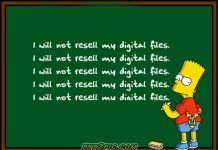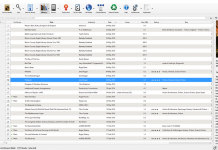 OK, this is for the e-book-hip Sara across the Pond—Pan Macmillan‘s Sara Loyd, there in the U.K.
OK, this is for the e-book-hip Sara across the Pond—Pan Macmillan‘s Sara Loyd, there in the U.K.
In a helpful, informative way that advances the debate, she’s challenges the assertion that publishers messed up in not climbing on the iPhone bandwagon. Of course, e-book boosters want publishing houses to climb on all kinds of bandwagons, not just The Phone’s. I mean that just as a clarifying aside, not a response to Sara, who followed up yesterday with some comments on other matters in the TeleBlog.
 With the above out of the way, here is a little more on (1) what I’d have done with the iPhone if I ruled the global e-book industry. I’ll also discuss Sara’s comments on (2) the ePub standard for e-books, (3) DRM and (4) Fictionwise‘s treatment of publishers.
With the above out of the way, here is a little more on (1) what I’d have done with the iPhone if I ruled the global e-book industry. I’ll also discuss Sara’s comments on (2) the ePub standard for e-books, (3) DRM and (4) Fictionwise‘s treatment of publishers.
Timely stuff! Because of the Tower of eBabel, I can’t read America America—said to be a "worthy successor" to All the King’s Men—on any program compatible with the iPhone or my iPod Touch. I suppose that eReader’s edition for both devices will eventually catch up with AA. But this is still one more reason for the ePub standard and the end of DRM (the enemy of compatibility)—given all the sales that the present horrors are costing. Read on. You’ll see Sara’s doing some good work on the ePub and DRM fronts. As for Fictionwise’s treatment of publishers, that’s also timely since the Pendergrast brothers are the only major source of DRM-capable e-book software for the iPod. I need to know yet more details here before reaching conclusions. Now on to the pre-launch Should-Haves!
The big iPhone Should-Haves—if I’d ruled the global e-book industry
Should-Have One: A big, fat e-book icon on the iPhone’s opening screen, regardless of Steve Jobs’ comment that people don’t read anymore. The icon could fire up an e-reading program of the reader’s choice. Right now, iPhone buyers can choose among e-mail services to which a featured icon steers them. Why not e-book programs? It still isn’t too late for this to happen. No need for extensive software development here. We’re simply talking about better promotion of existing e-book apps.
One way or another, the mail-, weather- and stock-related icons and the like made it to the iPhone’s main screen, with companies such as Google or Yahoo involved. So why not icons to lead users to books?
Granted, I don’t know if individual book publishers can pull this off by themselves. What’s more, let’s not shrug off Sara’s observation, made from the U.K., that a major iPhone e-book initiative "would have been (a) difficult for a very small department within a large publishing house and (b) quite possibly ultimately not a good use of our time." But read on! I’m talking about the book business as a whole, not simply Pan Macmillan, and I actually have a strategy in mind.
Apple sells a lot of computers to schools in the States and perhaps elsewhere, and we know that young people love iPods and that the iPod Touch is but a hint of things to come. So in the place of the IDPF and the Association of American Publishers and other industry groups in various countries, I’d shamelessly use the legitimate literacy angle, enlist the support of school and library organizations and remind Apple that it hasn’t been shy about playing up YouTube videos and music. How about giving books a chance if the schools are to keep buying from Apple? As the carrot, the various players could offer to team up with Apple on a literacy campaign.
Lest any favoritism be shown to a particular company, the same offer could also be made to other corporations such Amazon (reportedly interested in growing the Kindle market among the young). AAP could even let companies tweak its "Get Caught Reading" slogan to "Get Caught Reading on Your iPod" or whatever. A win for all!
Should-Have Two: Sample commercial books included with every iPhone/Touch or at least generous excerpts. The existing e-book apps are doing a good job of acquainting people with free public domain books—a noble cause. But what about commercial books, still in copyright, the kind that buy groceries and help pay down mortgages? When I bought a Palm TX, it even came with a complete novel from Pat Conroy, if I recall—perhaps The Prince of Tides. Or was that just the "Professional" version of eReader? Can’t recall. But you get the idea. Actually Should-Have Two could link to Should-Have One. The free book samples would make the iPhone all the more attractive as a purchase and pay back Apple for the icon. I know. We’re really talking about the involvement of not only Apple but also e-book software vendors, but I believe it would be worth the trouble to overcome the complexities. Maybe some of the included free books could be the starts of series, a strategy that has helped Baen and TOR in other contexts.
Should-Have Three: Work with public library systems and vendors to make it easy to download iPhone books. I’ve sent OverDrive—perhaps the largest supplier of popular trade books for libraries—a list of questions on library topics, and one of them is the iPhone. Just what the devil is OverDrive doing on the library front to tap the iPhone craze? Remember, libraries in effect are great marketers for bookstores. Plus, publishers enjoy revenue from library sales.
Should-Have Four: An end to what Sara calls "a confusing mess right now" within the App store. Don’t trust the techies to understand this on their own. The book industry should be pro-active and make a compelling argument for the extra revenue that a better-organized approach could yield. I’m with you, Sara, and so is Hadrien over at Feedbooks. He, too, hates books being confused with apps, if you go by a recent TeleBlog comment.
Why couldn’t Apple maintain the existing App store and iTunes arrangements but come up with a new book-oriented store—with powerful search features and well organized topic listings to encourage browsing. Perhaps this store and the e-reading programs could share the same main-screen icon, although of course the users could promote their favorite e-reading apps to the prime real estate on the screen.
The ePub question
Not much to write here, except Sara repeats the terrific news that "many publishers, including Pan Macmillan, are preparing their books in .epub." I hope that means just about the complete list (with exceptions for production challenges).
Significantly, Stanza, one of the more promising e-readers for the iPhone/Touch, is ePub capable. Let’s work to make ePub the format on the iPhone to bring down costs for publishers and readers alike.
The DRM mess: Encouraging words from Pan Macmillan
Sara writes, credibly, that "We are also actively talking to agents and authors re the DRM debate and trying to educate them out of their paranoia. It’s a long, slow job though and it is veeeeeeery time-consuming. At Pan Macmillan, we have taken this one step further, too, and have been actively seeking authors who will support non-drm’d ebooks. As a result, I think you’ll find we’re the only UK publishers who will have a small (but hopefully growing) list of drm-free ebooks by the end of this year. On today’s count, though, we still only have six books in this year’s programme where we have been able to do this. This is not for want of trying."
First off, kudos to Sara for her efforts. Second, it would be wonderful if she could share with us the arguments she is using against DRM. I suspect that they’re the same ones that members of the TeleBlog community have been making for years—namely, that DRM can be defeated with scans of paper books and actually penalizes legitimate owners. But I’d still like to see what she says. It would mean much more coming from a book publishing. Let us cherish her open-mindedness. I’ll open the main part of this blog to her if she’s inclined.
Third, while the rest of Pan Macmillan does not accept unsolicited manuscripts, it has launched a New Writing program that does. More established writers perhaps could work with their agents and publishers to consider Pan Macmillan as a U.K. outlet. I’ll certainly raise that issue with the DRM-hating American publisher of my own forthcoming novel. I hope that Pan Macmillan will become increasingly ready to say "No" to DRM-insistent writers and agents and "Yes" to those of a different mind. Books’ literacy and commercial merits should count most of all. But all things being equal, publishers should take a hard line and expect the holdouts to come around.
On Fictionwise’s terms for publishers
About the Fictionwise problem as she see its, Sara assure us that it has "nothing to do with pricing or DRM. I just think the discounts they demand essentially simply to hold and deliver a digital file are outrageous."
Before making up my mind, I’d love to hear some dollar/pound figures. Macmillan is in the digital warehouse business and that may or may not influence what Sara has to say. I’d welcome Fictionwise’s side, too.
From a consumer viewpoint, Fictionwise has been one of the better houses. Its prices are reasonable, given what it must pay for books, and Steve and Scott Pendergrast have used an e-mail list to listen closely to their retail customers. Here’s hoping that Macmillan and Fictionwise can work out their differences in an amicable way.


































David, I suspect authors would love to see their works as first-class apps, instead of being hidden behind the publisher’s App/reader/bookstore. I think that’s the wave of the future…
David writes:
> iPhone buyers can choose among e-mail services
> to which a featured icon steers them. Why not
> e-book programs?
You are confusing programs and protocols.
The icon on the iPhone’s home page is associated with a single program, Apple’s own mail client, which implements the two protocols, POP3 and IMAP, that are used to fetch mail from a server. For ease of use they have provided some pages that simplify the process of configuring the program for some of the more popular mail services, but this does not involve the use of any separate program associated with those services.
There is no industry standard file format for e-books, let alone a protocol for accessing them over the net, so the idea of a “standard” icon on the home page isn’t feasible unless Apple should decide to develop its own e-book reader or to strike a deal with a third party that would generate revenue for Apple.
I seriously doubt that Apple would be interested in developing its own e-book reader unless they decided to get into the publishing business, presumably through the iTunes store. Despite comments from His Steveness that this is not a market in which Apple is interested, it could still happen. Remember, it was just a few years ago that he said Apple wasn’t interested in developing a phone. 😉
Hi, Todd. Same concept, though—whether program or configuration. And remember, eReader can already runs on the iPhone and Mobi is on the way.
The e-book icon would merely make newbies aware of e-books and let them choose apps to go on the desktop—with the option for one of them to be directly accessible from the e-book icon. Further tweaks could be made through general setup.
Now about standards: My approach would get around that issue by letting people choose from different programs with different format capabilities, although obviously I’d hope that ePub would triumph.
As for His Steveness’s statement on books, well, you’ve already already covered that angle nicely.
Thanks,
David